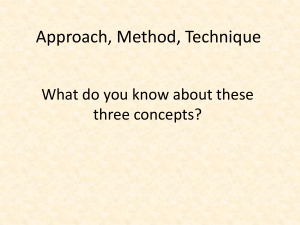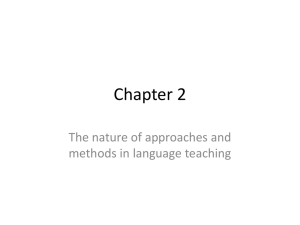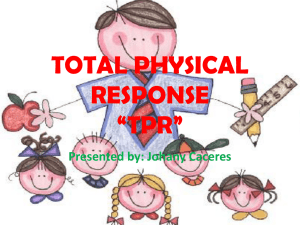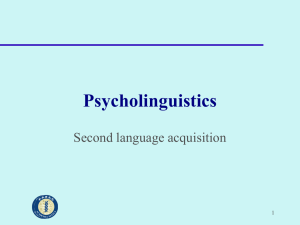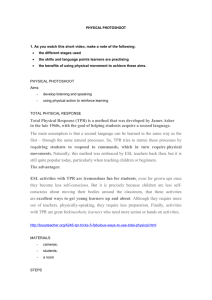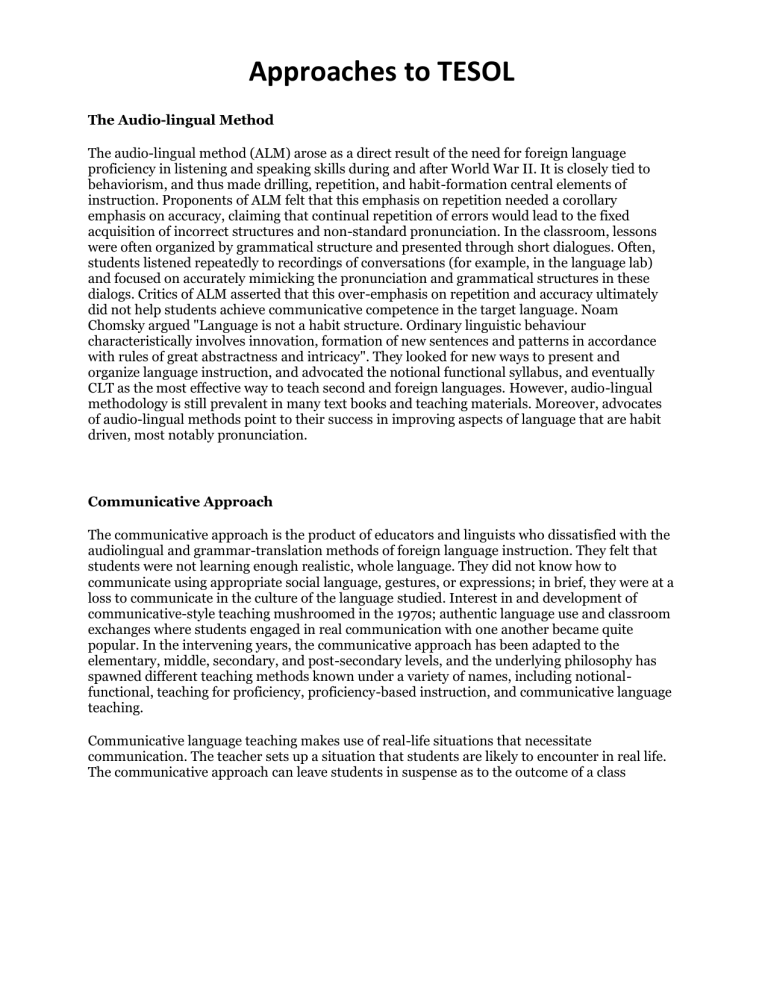
Approaches to TESOL The Audio-lingual Method The audio-lingual method (ALM) arose as a direct result of the need for foreign language proficiency in listening and speaking skills during and after World War II. It is closely tied to behaviorism, and thus made drilling, repetition, and habit-formation central elements of instruction. Proponents of ALM felt that this emphasis on repetition needed a corollary emphasis on accuracy, claiming that continual repetition of errors would lead to the fixed acquisition of incorrect structures and non-standard pronunciation. In the classroom, lessons were often organized by grammatical structure and presented through short dialogues. Often, students listened repeatedly to recordings of conversations (for example, in the language lab) and focused on accurately mimicking the pronunciation and grammatical structures in these dialogs. Critics of ALM asserted that this over-emphasis on repetition and accuracy ultimately did not help students achieve communicative competence in the target language. Noam Chomsky argued "Language is not a habit structure. Ordinary linguistic behaviour characteristically involves innovation, formation of new sentences and patterns in accordance with rules of great abstractness and intricacy". They looked for new ways to present and organize language instruction, and advocated the notional functional syllabus, and eventually CLT as the most effective way to teach second and foreign languages. However, audio-lingual methodology is still prevalent in many text books and teaching materials. Moreover, advocates of audio-lingual methods point to their success in improving aspects of language that are habit driven, most notably pronunciation. Communicative Approach The communicative approach is the product of educators and linguists who dissatisfied with the audiolingual and grammar-translation methods of foreign language instruction. They felt that students were not learning enough realistic, whole language. They did not know how to communicate using appropriate social language, gestures, or expressions; in brief, they were at a loss to communicate in the culture of the language studied. Interest in and development of communicative-style teaching mushroomed in the 1970s; authentic language use and classroom exchanges where students engaged in real communication with one another became quite popular. In the intervening years, the communicative approach has been adapted to the elementary, middle, secondary, and post-secondary levels, and the underlying philosophy has spawned different teaching methods known under a variety of names, including notionalfunctional, teaching for proficiency, proficiency-based instruction, and communicative language teaching. Communicative language teaching makes use of real-life situations that necessitate communication. The teacher sets up a situation that students are likely to encounter in real life. The communicative approach can leave students in suspense as to the outcome of a class exercise, which will vary according to their reactions and responses. The real-life simulations change from day to day. Students' motivation to learn comes from their desire to communicate in meaningful ways about meaningful topics. Total Physical Response Total physical response (TPR) is a method developed by Dr. James J. Asher, a professor emeritus of psychology at San José State University, to aid learning second languages. The method relies on the assumption that when learning a second or additional language, language is internalized through a process of codebreaking similar to first language development and that the process allows for a long period of listening and developing comprehension prior to production. Students respond to commands that require physical movement. TPR is primarily intended for ESL/EAL teachers, although the method is used in teaching other languages as well. The method became popular in the 1970s and attracted the attention or allegiance of some teachers, but it has not received generalized support from mainstream educators. According to Asher, TPR is based on the premise that the human brain has a biological program for acquiring any natural language on earth - including the sign language of the deaf. The process is visible when we observe how infants internalize their first language. It looks to the way that children learn their native language. Communication between parents and their children combines both verbal and physical aspects. The child responds physically to the speech of their parent. The responses of the child are in turn positively reinforced by the speech of the parent. For many months the child absorbs the language without being able to speak. It is during this period that the internalization and codebreaking occurs. After this stage the child is able to reproduce the language spontaneously. With TPR the language teacher tries to mimic this process in class. The method also promises double efficiency in terms of rate of learning, according to several studies in the literature and referenced in the above book. In the classroom the teacher and students take on roles similar to that of the parent and child respectively. Students must respond physically to the words of the teacher. The activity may be a simple game such as Simon Says or may involve more complex grammar and more detailed scenarios. TPR can be used to practice and teach various things. It is well suited to teaching classroom language and other vocabulary connected with actions. It can be used to teach imperatives and various tenses and aspects. It is also useful for story-telling. Because of its participatory approach, TPR may also be a useful alternative teaching strategy for students with dyslexia or related learning disabilities, who typically experience difficulty learning foreign languages with traditional classroom instruction. According to its proponents, it has a number of advantages: Students will enjoy getting up out of their chairs and moving around. Simple TPR activities do not require a great deal of preparation on the part of the teacher. TPR is aptitudefree, working well with a mixed ability class, and with students having various disabilities. It is good for kinesthetic learners who need to be active in the class. Class size need not be a problem, and it works effectively for children and adults. However, it is recognized that TPR is most useful for beginners, though it can be used at higher levels where preparation becomes an issue for the teacher. It does not give students the opportunity to express their own thoughts in a creative way. Further, it is easy to overuse TPR-- "Any novelty, if carried on too long, will trigger adaptation." It can be a challenge for shy students. Additionally, the nature of TPR places an unnaturally heavy emphasis on the use of the imperative mood, that is to say commands such as "sit down" and "stand up". These features are of limited utility to the learner, and can lead to a learner appearing rude when attempting to use his new language. Whole Language Approach Whole language describes a literacy philosophy which emphasizes that children should focus on meaning and strategy instruction. It is often contrasted with phonics-based methods of teaching reading and writing which emphasize instruction for decoding and spelling. However, from whole language practitioners' perspective this view is erroneous and sets up a false dichotomy. Whole language practitioners teach to develop knowledge of language including the graphophonic, syntactic, semantic and pragmatic aspects of language. Within a whole language perspective, language is treated as a complete meaning-making system, the parts of which function in relational ways. It has drawn criticism by those who advocate "back to basics" pedagogy or reading instruction because this whole language is based on a limited body of scientific research. Whole language is an educational philosophy that is complex to describe, particularly because it is informed by multiple research fields including but not limited to education, linguistics, psychology, sociology, and anthropology. Several strands run through most descriptions of whole language: focus on making meaning in reading and expressing meaning in writing; Constructivist approaches to knowledge creation, emphasizing students' interpretations of text and free expression of ideas in writing (often through daily journal entries). emphasis on high-quality and culturally-diverse literature; integrating literacy into other areas of the curriculum, especially math, science, and social studies; frequent reading o with students in small "guided reading" groups o to students with "read a loud" o by students independently; reading and writing for real purposes; focus on motivational aspects of literacy, emphasizing the love of books and engaging reading materials Meaning-centered whole to part to whole instruction where phonics are taught contextually in "embedded" phonics (different from synthetic or analytic phonics); and emphasis on using and understanding the meaning making role of phonics, grammar, spelling, capitalization and punctuation in diverse social contexts. The Natural Approach The Natural Approach was developed by Tracy Terrell and Stephen Krashen, starting in 1977. It came to have a wide influence in language teaching in the United States and around the world. The Communicative view of language is the view behind the Natural Approach. Particular emphasis is laid on language as a set of messages that can be understood. The Natural Approach is based on the following tenets: Language acquisition (an unconscious process developed through using language meaningfully) is different from language learning (consciously learning or discovering rules about a language) and language acquisition is the only way competence in a second language occurs. (The acquisition/learning hypothesis) Conscious learning operates only as a monitor or editor that checks or repairs the output of what has been acquired. (The monitor hypothesis) Grammatical structures are acquired in a predictable order and it does little good to try to learn them in another order.(The natural order hypothesis). People acquire language best from messages that are just slightly beyond their current competence. (The input hypothesis) The learner's emotional state can act as a filter that impedes or blocks input necessary to acquisition. (The affective filter hypothesis) The objectives of the Natural Approach are to help beginner become intermediates and to depend on learner needs. And its syllabus is a communicative syllabus. The Natural Approach adopts techniques and activities from different sources but uses them to provide comprehensible input. Art / Musical Approach It is said that there is a strong proof of using music in the TESOL classroom. Music and language are tied together in brain processing by pitch, rhythm and by symmetrical phrasing. Music plays a very important role in learning a language. It can help familiarize the students with the expressions easily and gives a fun way to learn it. Direct Based Approach / Communicative This approach emphasizes on the target language and utilizes no native language in the classroom. To make the students actually apply all the targets, conversational exercises and spoken situations can be used. This is essential for the students because they get to practise and be more comfortable on how to use those expressions in real life situations. Grammar Memorization Speech This is the complete opposite of the direct based approach. Using this method, students are taught the grammatical structures. Some of the activities to attain the objectives of this approach are memorization and applying all grammar rules. Vocabulary Approach This approach refers to the introduction of words, and a series of vocabulary drill. Students can build their vocabularies by incidental acquisition or through direct study. To strengthen students' vocabulary, activities like "listen and repeat", "quick peek technique" and "what's missing?" can be used. Rassias Method It is a method that uses a lot of entertainment while teaching a language like English. Students repeat words several times for practice while keeping their enthusiasm toward the lessons. Boosting the students’ confidence is one of the primary goals of this teaching style. Rassias method uses of big gestures and have the students sit in a circle rather than the traditional classroom setup. Strategies to TESOL 1. Cognitive strategies are strategies that help learners make and strengthen associations between new and already-known information and facilitate the mental restructuring of information. Examples are guessing from context, analyzing, reasoning inductively and deductively, taking systematic notes and reorganizing information. 2. Mnemonic strategies are strategies that help learners link a new item with something known, which are useful for memorizing information in an orderly string (e.g acronyms) in various ways; some examples are: by sounds also known as rhyming, by body movement also known as TPR, etc. 3. Metacognitive strategies help learners manage 1. themselves as learners, 2. the general learning process and 3, specific learning tasks. One group of metacognitive strategies helps individuals know themselves better as language learners. Another set of metacognitive strategies relates to managing the learning process in general and includes identifying available resources, deciding which resources are valuable for a given task, setting a study schedule, finding or creating a good place to study, etc. while other metacognitive strategies help learners deal effectively with a given language task, not just with the overall process of language learning. 4. Affective strategies include identifying one’s feelings (e.g anxiety, angry and contentment) and becoming aware of the learning circumstances or tasks that evoke them. One good way is to use a language learning diary to record one’s feelings about language learning. However, the acceptability or viability of affective strategies might vary from culture to culture. 5. Social strategies facilitate learning with others and help learners understand the culture of the language they are learning. Examples of this strategy are asking questions for clarifications or confirmation, asking for help, learning about social or cultural norms and values and studying together outside of class.
